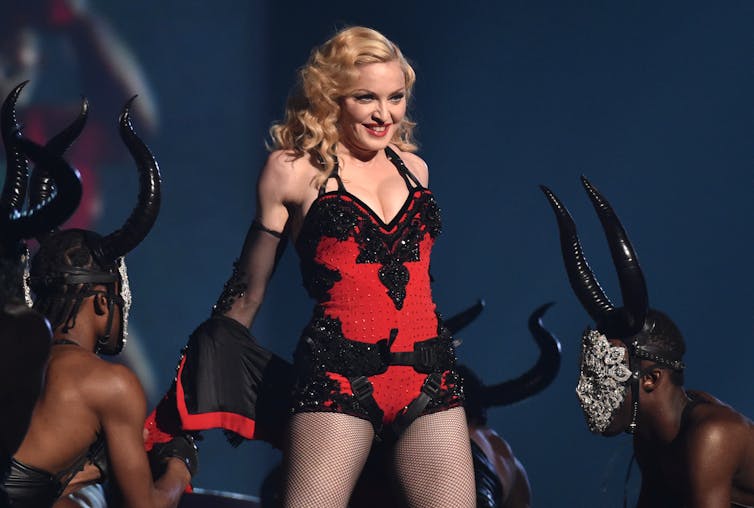It’s Easter weekend, which means many of us will be kicking back with the greatest hits on repeat. But whether you’re a boomer, or an ‘80s or '90s kid, you might be surprised to find many of your favourite tunes are more concerned about Jesus and God than you’d realised.
Many chart-topping songs in Western music delve into themes of faith (especially Christianity), spirituality and divinity. But unlike Christmas music, most of these come from a rock tradition.
Early gospel makes the charts
Hits by some of rock’s greatest guitarists, such as George Harrison, Lenny Kravitz and Prince, feature strong guitar riffs that create a sense of aural transcendence. These riffs, which involve a repeated note sequence or chord progression, help to define their songs.
This intertwining of guitar and Christian spirituality dates back to the emergence of rock music in the 1940s. American rock pioneer Sister Rosetta Tharpe (1915–73), from the Pentecostal church, used powerful guitar riffs that surged with soulfulness.
Tharpe’s 1944 gospel song Strange Things Happening Every Day – covered by Yola for the 2022 film Elvis – is a great example.
Using electric guitar, and the theological message “Jesus is the holy light”, Tharpe’s was the first song to cross over from gospel into a mainstream “race” chart in the US. “Race music”, which eventually became R&B, was the term used to describe African American music (but generally just referred to secular music).

The rise of spirituality and counterculture
Christian rock also has roots in the 1960s US counterculture “hippie” movement. The Jesus People brought a Christian vibe to this movement, leading to works such as Andrew Lloyd Webber’s 1971 rock opera Jesus Christ Superstar, which is still being performed more than 50 years later.
Throughout the 1960s and '70s, plenty of songs exploring themes of God, faith and spirituality climbed their way into the Top 20. For example, Norman Greenbaum’s 1970 track Spirit in the Sky became popular during the Christian rock movement.
It was joined in the same year by Harrison’s hit My Sweet Lord, which is particularly interesting because of its mix of spiritual undertones, which reflect the West’s growing interest in Eastern spirituality at the time.
Along with the repetition of “lord” (which is said around 40 times) and the use of the Christian/Hebrew word “Hallelujah”, the song also includes chants of “Hare Krishna” and “Hare Rama”, praising the Hindu gods.
My Sweet Lord became the highest-selling single in the United Kingdom in 1971, as well as the first solo number-one hit by a member of the Beatles. It wasn’t all smooth sailing, though. The song sparked controversy, and a lawsuit that claimed it was too similar to The Chiffons’s 1963 hit He’s So Fine.
For some, My Sweet Lord is considered a Christian song – at least the until the Hindu chants begin. But the mixing of religious elements was seen by some conservative Christians as satanic, or pagan (even though Hinduism isn’t a pagan religion).
Music throughout the 1960s and '70s, while it still touched on religious themes, grew much more rebellious and edgy with bands like The Rolling Stones and Black Sabbath.
Topics such as sex, drugs and hedonism became common – as did protesting against traditional values. From this cocktail emerged the view that rock was the devil’s music.
Read more: 'Jesus People' – a movement born from the 'Summer of Love'
The 80s: when religion met raunchy
The 1980s and '90s continued the trend of intertwining spirituality and popular music. Many of these tracks stirred deep discussions on faith, cementing music’s power as a medium for expressing complex themes.
Lenny Kravitz’s Are You Gonna Go My Way (1993) was written to sound like the lyrics came from Jesus himself:
I was born long ago, I am the chosen. I’m the one. I have come to save the day, and I won’t leave until I’m done […] But what I really want to know is, are you gonna go my way?
Prince’s Lets Go Crazy (1984) was a metaphor for God and Satan, hinted at in the line “are we gonna let the elevator bring us down? Oh no let’s go!”
Meanwhile, Madonna’s 1989 smash Like a Prayer made more than one wave when it topped the charts 35 years ago. The music video stirred up quite a controversy by mixing the sacred with the profane. Among other things, Madonna is shown dancing among burning crosses, and kissing a black Christ who comes to life from being a statue.
The video conveys messages about prejudice, racism, violence and sexuality. Some networks refused to show it, deeming it inappropriate for children. Others aired it with a warning it might offend viewers. The Catholic Church was outraged and the Vatican condemned it.
Nonetheless, the video achieved huge commercial success, winning MTV’s 1989 Video Music Award for Viewer’s Choice. Even now, it remains a pinnacle of music video art.
Religion is still everywhere in music
Today, most of us won’t bat an eyelid when we see Lil Nas X giving Satan a lapdance, and that’s probably because of the work of artists like Madonna.

It’s interesting that, despite a rise in secularism, the intersection of the sacred and secular in music has persisted. Leonard Cohen’s Hallelujah, with its intermingling spiritual and sexual themes, is still one of the most popular songs of all time.
Today, many of the world’s most famous contemporary artists continue the tradition of engaging with spiritual and religious themes. Take Drake’s 2018 hit God’s Plan, or The Weeknd’s highly acclaimed 2022 album Dawn FM, replete with spiritual undertones and religious symbolism.
Perhaps it’s just in the nature of religion to evoke feeling and inspire, even for those who aren’t “religious” themselves. Or perhaps we’ve collectively realised musicians can experiment with themes and take risks, and it won’t bring about the end of the world.
Read more: Lil Nas X's dance with the devil evokes tradition of resisting, mocking religious demonization

